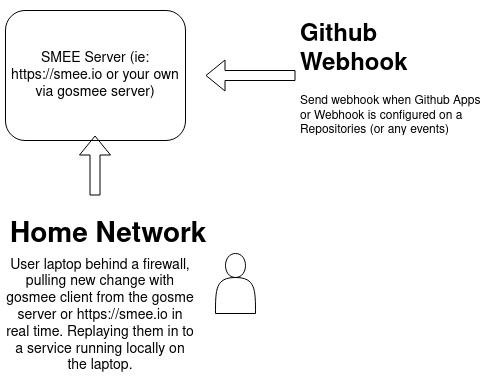Gosmee is a versatile webhook relayer that can be conveniently executed anywhere.
Gosmee enables you to relay webhooks from either itself (as a server) or from https://smee.io to your local notebook.
With gosmee, you can effortlessly expose the service on your local network or behind a VPN, allowing a public service (such as GitHub) to push webhooks to it.
For instance, if you configure your GitHub Webhook to direct to a https://smee.io/ URL or where gosmee server is listening, you can then use the gosmee client on your local notebook to obtain the events from the server and forward them to the local service, thereby establishing a connection between the GitHub webhook and your local service on your workstation.
For the people who rather prefer to understand on how it works with a small diagram:
Go to the release page and choose your archive or package for your platform.
brew tap chmouel/gosmee https://github.com/chmouel/gosmee
brew install gosmeeyay -S gosmee-bindocker run ghcr.io/chmouel/gosmee:latestgo install -v github.com/chmouel/gosmee@latestCheckout the directory and use :
-$ make build
-$ ./bin/gosmee --helpThis repository includes a flake (see NixOS Wiki on
Flakes).
If you have the nix flake command enabled (currenty on
nixos-unstable, nixos-version >= 22.05)
nix run github:chmouel/gosmee -- --help # your args are herealso use it to test and develop the source code:
nix develop # drops you in a shell with all the thing needed
nix flake check # runs testsSystem Service example file for macOS and Linux is available in the misc directory.
Shell completion is available with:
# BASH
source <(gosmee completion bash)
# ZSH
source <(gosmee completion zsh)If you intend to use https://smee.io, you might want to generate your own smee URL by visiting https://smee.io/new.
Once you have it, the basic usage is as follows:
gosmee client https://smee.io/aBcDeF https://localhost:8080 This command will relay all payloads received at the smee URL to a service running on http://localhost:8080.
Another option is to save all the relays as shell script that can be replayed without having to recreate the event:
gosmee client --saveDir /tmp/savedreplay https://smee.io/aBcDeF https://localhost:8080This command will save the JSON data of new payloads received at your smee URL to /tmp/savedreplay/timestamp.json and create a shell script with cURL options to /tmp/savedreplay/timestamp.sh. You can replay the webhook effortlessly by repeatedly running the shell script.
You can ignore certain events (identified by GitLab/GitHub/Bitbucket) by adding one or more --ignore-event flags.
If you only want to save the payloads but not replay them, you can use --noReplay.
By default, you will have colored emoji output unless you specify --nocolor as an argument.
With gosmee server you can use your own server rather than https://smee.io
as relay. By default gosmee server will bind to localhost on port 3333
which is not very useful. You probably want to expose it to your public IP or
behind a proxy with the flags --address and --port.
You really want to secure that endpoint, you can generate some letsencrypt
certificate and use the --tls-cert and --tls-key flags to specify them.
If you're really lazy (and who isn't) you can just give the flag --auto-cert and
it will automatically generate certs. Unfortunately this require to run on
port 443 which need root and very secure. It may be better to just have caddy installed in front of gosmee.
To use it you go to your URL and a suffix with your random ID. For example:
The random ID accepted to the server needs to be 12 characters (and you probably want to be it random).
With /new you can easily generate a random ID, ie:
% curl http://localhost:3333/new
http://localhost:3333/NqybHcEiCaddy is the best way to run gosmee server, you just need this:
https://webhook.mydomain {
reverse_proxy http://127.0.0.1:3333
}It will automatically configure a letsencrypt certificate for you
Running gosmee server behind nginx may require some configuration to work properly.
Here is a proxy_pass location to a locally running gosmee server on port localhost:3333:
location / {
proxy_pass http://127.0.0.1:3333;
proxy_set_header Connection '';
proxy_http_version 1.1;
chunked_transfer_encoding off;
proxy_read_timeout 372h;
}There is maybe some errors appearing some time with nginx with long running connections.
You can expose an internal kubernetes deployment or service with gosmee by using this file.
Adjust the SMEE_URL in there to your endpoint and the http://deployment.name.namespace.name:PORT_OF_SERVICE URL is the Kubernetes internal URL of your deployment running on your cluster, for example:
- Most of the works is done by the go-sse library.
- Used previously pysmee but it seems that the underlying sse library is broken with chunked transfer.
- Fediverse - <@chmouel@chmouel.com>
- Twitter - <@chmouel>
- Blog - <https://blog.chmouel.com>

